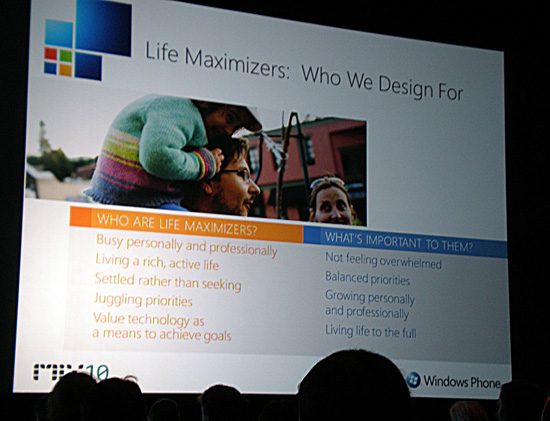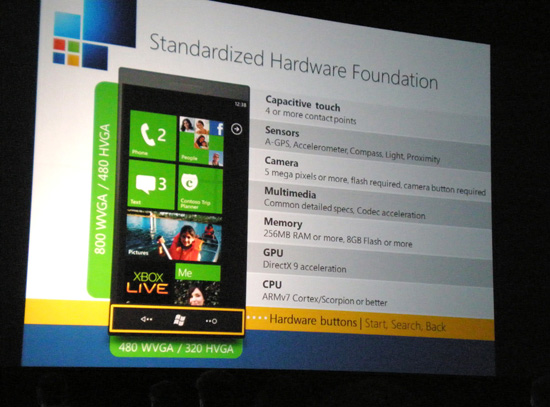Windows Phone 7 Series at MIX10
by Brian Klug on March 16, 2010 12:00 AM EST- Posted in
- Smartphones
- Mobile
Different Target Audience
I asked some of the XNA development team what they thought the biggest takeaway from the entire Phone 7 Series reboot should be, and the response was nearly unanimous: It represents a completely different target demographic focus; consumers.
Microsoft is learning from its experience with Windows Mobile by designing the phone entirely for end users and ordinary consumers; not strictly businesspeople. This target persona has been nicknamed a "Life Maximizer," and it represents the end-user the entire design, from UI to hardware, is being designed around.

Joe Belifore, VP of Phone Development, was forthcoming about both the demographic being targeted in previous Windows Mobile releases, and the tensions inherent in the development cycle for previous Windows Mobile devices. Previously, mobile operators would approach OEMs with a rough list of specifications for hardware they perceived would fill a need a gap in their lineup. The OEMs and mobile operators would work together with an existing reference design, fleshing out a device with potentially different dialers, interfaces, and end user experiences. It's a fair argument that much of the experience fragmentation that this resulted in ultimately was both Windows Mobile's biggest strength, and biggest weakness.
As we noted earlier, Phone 7 Series intends to change all of that by mandating a consistent message to end users. Part of that is also manifested in the hardware mandated now, which Microsoft has released additional details about:

Standardized Hardware Set
The specification list we heard about earlier has been fleshed out with some additional details which I've added emphasis to.
Hardware requirements are:
- Capacitive Touch
- 4 or more contact points
- Sensors
- A-GPS, Accelerometer, Compass, Light, Proximity
- Camera
- 5 megapixels or more, flash required, camera button required
- Multimedia
- Common detailed specs, Codec Acceleration
- Memory
- 256 MB RAM or more, 8 GB Flash or more
- GPU
- DirectX 9 acceleration
- CPU
- ARMv7 Cortex/Scorpion or better
- Screen
- Two Supported Displays
- 480 x 800 WVGA : Aspect Ratio 3:5
- 320 x 480 HVGA : Aspect Ratio 2:3
Note that Microsoft is now officially supporting two display resolutions; WVGA and HVGA. These are slightly different aspect ratios, with 320 x 480 HVGA being the standard 3:2 aspect ratio, and 480 x 800 being 5:3 aspect ratio. At the very least, this is something developers can be proactive about and have in mind when building software, as opposed to having the design change after the fact. Hardware launching holiday 2010 will release with 480 x 800 WVGA displays; hardware with 320 x 480 screens will launch later at some unspecified date.
I made note of this to the same XNA team mentioned earlier, who noted that scaling down applications should in theory be easier than scaling up for developers. In addition, they're looking to mitigate the aspect ratio in a number of different ways.
As for the all-important SoC choice, Microsoft is still being very tight-lipped about whether they've picked Snapdragon or one of the many other ARM-licensees' hardware designs. Reps repeatedly declined to discuss what hardware is at the core of current example hardware or whether they'll even mandate a particular chipset. In all likelihood, they'll define minimum requirements and let hardware partners meet or exceed them. Time will tell whether a particular chipset emerges as part of the requirement.
An interesting additional note not part of hardware requirements specifically, but still relevant, is that sync can be performed both tethered through USB to the computer, or over WiFi. Handsets will periodically poll computers over WiFi to see if their primary sync computer is connectible, and if so, sync. Part of the plan is to sync nightly in a manner transparent to the user and transfer photos, notes, and music so that users are never more than a day behind. I had some reservations about how well secured this method is in the long run, but we'll see more as MIX10 continues. Active Sync is dead (to much applause), and the Zune software was announced as the sync platform's successor.










24 Comments
View All Comments
Tanclearas - Wednesday, March 17, 2010 - link
Awesome! So all I have to do is purchase a Windows Server license, and probably some other Microsoft platform/framework/service license to install on it, and probably client licenses for each phone needing to connect, and ...zicoz - Wednesday, March 17, 2010 - link
Well this is a system for companies to install their "Special programs". If you only want to install it on a few phones, you can just use the "beta solution".cknobman - Tuesday, March 16, 2010 - link
So I cannot develop my own personal software and install it on the phone?Everything has to go through their approval process and be placed ont the app store?
Please tell me this isnt the case. What about the thousands of developers that want to develop their own app for whatever reason but have absolutely no desire to make it public?
Im hoping I misread somewhere.
Reklats - Wednesday, March 17, 2010 - link
For the specific scenario of a developer wanting to write a program and install it on their phone, this should be doable already. Development is done using Visual Studio (express version is free), which allows for USB deployment of applications for debugging and development. Since I don't have any hardware to try it out with, I'm making an assumption that a deployed app will still run without the debugger attached.Given that the basic functionality exists, I would not be surprised to see someone release a utility to deploy compiled applications via USB. If there is enough demand, I expect Microsoft to release something aside from it's enterprise business offering.
MonkeyPaw - Tuesday, March 16, 2010 - link
If MS doesn't allow you to run private enterprise apps, then they are really missing a big chunk of their market. I can easily see an inventory program that would really benefit from GPS and the ability to sync to a server immediately. At the same time, I wouldn't want that app to be up for purchase by my competition. If you could develop privately, you could really boost your small business.straubs - Tuesday, March 16, 2010 - link
Not only that, but it costs $99 PER APP, in addition to the $99/year developer fee.http://developer.windowsphone.com/Help.aspx">http://developer.windowsphone.com/Help.aspx
zicoz - Tuesday, March 16, 2010 - link
I think I read somewhere that as a developer you can "unlock" x number of phones and install your programs directly.QuietOC - Tuesday, March 16, 2010 - link
"480 x 800 being 4:3 aspect ratio"800x480 should be a 5:3 aspect ratio.
nerdtalker - Tuesday, March 16, 2010 - link
Thanks, that's what I get for trying to do math late at night ;)Should be corrected soon!
Cheers,
Brian
HighTech4US - Tuesday, March 16, 2010 - link
Isn't the only SOC ARM design with GPU DirectX 9 acceleration the nVidia Tegra.